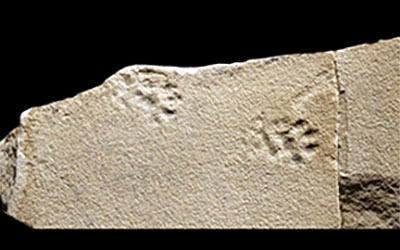Last updated: April 15, 2020
Lesson Plan
Making a Trace Fossil

- Grade Level:
- Upper Elementary: Third Grade through Fifth Grade
- Subject:
- Science
- Lesson Duration:
- 30 Minutes
- Additional Standards:
- 3rd Grade: 3-LS4-1, 3-LS4-2, and 3-LS4-3
Essential Question
How are trace fossils useful for learning about ancient life?
Objective
Distinguish between trace fossils and sedimentary structures or non-biological processes preserved in rocks
Background
Teachers should read and review information in A Fossil’s Journey with students.
Teachers should print off the Paleontology Museum Trace Fossil Specimen Cards.
Preparation
Materials
Shallow trays or pie plates
Modeling clay
Carving tools such as plastic knives and spoons, popsicle sticks, etc.
Specimen Cards
Set up
Make sure students understand the difference between a trace fossil and an impression made in sediment by non-biological processes preserved in rocks like ancient ripple marks, mud cracks, or raindrops preserved in rock. They do not represent activities of living things, and they are not trace fossils. A trace fossil is evidence of the activity of a living organism. Trace fossils could include an organism’s footprints, burrow tunnels, root cavities, eggs, nests, or coprolites. Have students choose a type of trace fossil to recreate that is made from an ancient organism that is now extinct. Make sure to give them time to research what the trace fossil looks like as well as the organism that makes it. Encourage students to be creative and not just recreate the standard "T-Rex footprint". Tell students to keep the identity of their trace fossil and ancient organism a secret from other classmates.
Procedure
Step One: Distribute modeling clay to each student and have them mold their trace fossil.
Step Two: When completed, have each student fill out a specimen card that matches their trace fossil.
Step Three: Once everyone is finished, each student can take a turn presenting their trace fossil to the class. Have the other students try and guess what ancient organism made the trace fossil.
Step Four: Create a classroom museum by displaying all the trace fossils with specimen cards around the classroom.
Step Five: Have a class discussion and ask students if they could determine most of the ancient organisms based on just their trace fossil.
Step Six: Complete How Living Things Become Fossils Lesson Plan.
Step Seven: Complete Some Parts Make Better Fossils than Others Lesson Plan.
Step Eight: Complete the Post-Unit Questions found on A Fossil's Journey.
Vocabulary
Clastic Sediments: sediments result from the breakdown, through weathering, of pre-existing rocks.
Curator: a museum scientist.
Diagenesis: everything that happens to sediment after it is deposited. A potential fossil may be dissolved in the process of diagenesis, and other times it may become mineralized.
Fossil: any naturally occurring evidence of past life. Fossils need not be mineralized or enclosed in rock.
Organic sediments: pieces of tissues of plants or animals such as leaf litter on a forest floor.
Paleontologists: scientists who study fossils to understand the history of life on Earth.
Preparation: when paleontologist clean dirt and surrounding rocks off the fossil, glue it together (if broken) and store it.
Prospecting: to search the ground for fossils.
Metamorphic rocks: rocks changed by heat and pressure.
Mineralization or Petrification: the condition when a fossil has effectively turned to stone.
Trace Fossil: an impression of the animal or plant after its death such as a natural mold of a shell.
Sedimentary Structures: non-biological processes preserved in rocks like ancient ripple marks, mud cracks, or raindrops preserved in rock. They do not represent activities of living things, and they are not trace fossils.
Contact Information
Email us about this lesson plan
